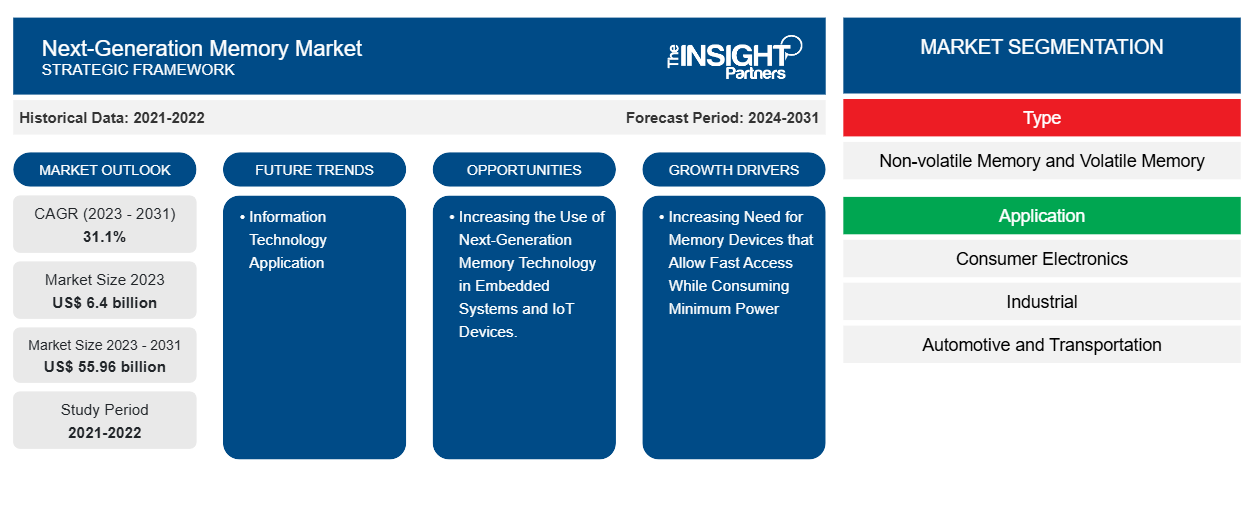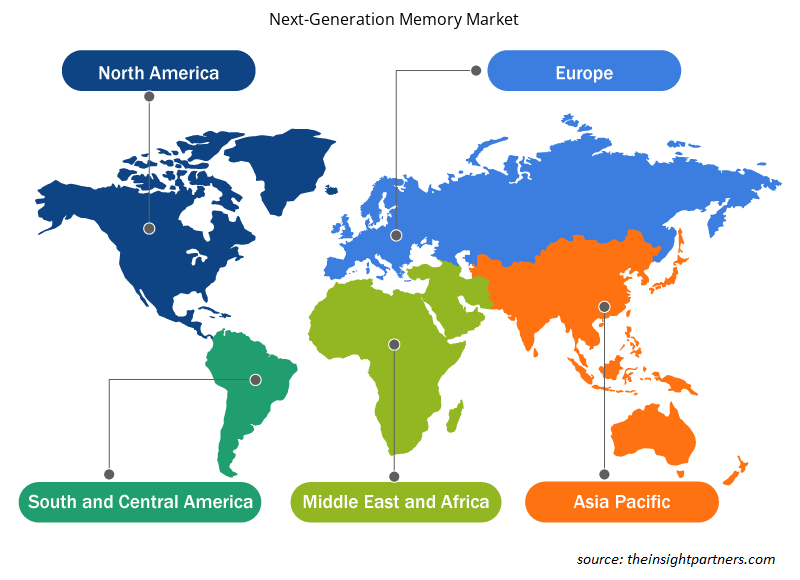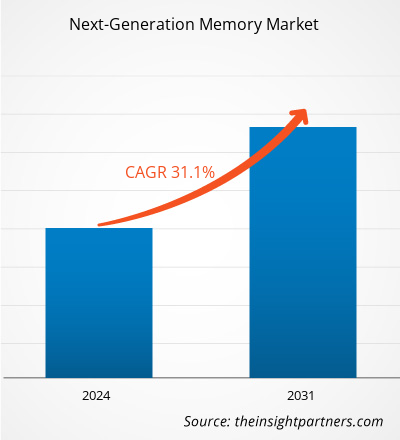The next-generation memory market size is projected to reach US$ 55.96 billion by 2031 from US$ 6.4 billion in 2023. The market is expected to register a CAGR of 31.1% in 2023–2031. The next-generation memory market is expanding due to growing demand for fast access and low power consumption, as well as growing adoption in enterprise storage and smartphones and smart wearables.
Next-Generation Memory Market Analysis
Emerging technologies such as machine learning (ML), artificial intelligence (AI), the Internet of Things (IoT), big data, and so on are driving demand for memory devices with high bandwidth, scalability, and low power consumption. This, together with the increased demand for business storage, is one of the primary factors driving the market's growth.
Next-Generation Memory Market Overview
Next-generation memory is a type of cutting-edge computer memory technology currently in development. These advancements overcome the constraints of conventional memory types like DRAM and NAND Flash. The major goal is to significantly improve aspects crucial to business performance, such as speed, durability, energy efficiency, and storage capacity. These technologies frequently provide increased data density, allowing enterprises to store more information in a smaller physical footprint. Adopting these advanced technologies can help firms gain a competitive advantage by allowing for faster and more efficient data processing, which is critical in today's data-driven industry.
Customize This Report To Suit Your Requirement
You will get customization on any report - free of charge - including parts of this report, or country-level analysis, Excel Data pack, as well as avail great offers and discounts for start-ups & universities
Next-Generation Memory Market: Strategic Insights

- Get Top Key Market Trends of this report.This FREE sample will include data analysis, ranging from market trends to estimates and forecasts.
You will get customization on any report - free of charge - including parts of this report, or country-level analysis, Excel Data pack, as well as avail great offers and discounts for start-ups & universities
Next-Generation Memory Market: Strategic Insights

- Get Top Key Market Trends of this report.This FREE sample will include data analysis, ranging from market trends to estimates and forecasts.
Next-Generation Memory Market Drivers and Opportunities
Increasing Need for Memory Devices that Allow Fast Access While Consuming Minimum Power to Favor Market
As businesses generate more data and use cloud storage, there is a growing demand for high-capacity, rapid-storage memory. Advancements in product performance are propelling the semiconductor sector forward. Emerging non-volatile memory technologies, including RRAM, MRAM, FeRAM, and NRAM, offer higher scalability, density, speed, and endurance than traditional technologies, meeting the demand for high speed, low power consumption, and scalability. Emerging memory technologies typically have a response time of 1-10 ns to meet command requirements. The switching time refers to the time it takes for memory to fulfill specified requirements after a command.
Increasing the Use of Next-Generation Memory Technology in Embedded Systems and IoT Devices.
Increasing the adoption of next-generation memory technology in embedded systems. The rising replacement of traditional memories with next-generation memories provides a considerable opportunity for industry participants. MRAM and ReRAM have high read and low power consumption, write speeds, and non-volatility, making them ideal for embedded systems and IoT devices. These memories can improve instant-on capabilities, energy economy, and data retention in smart devices. These memories can withstand a high number of read-and-write cycles without deterioration. This capability is crucial for IoT and embedded devices that require regular data updates to maintain dependability and lifetime. Next-generation memory technologies, such as MRAM and ReRAM, provide low latency and high-speed access, enabling in-memory computation.
Next-Generation Memory Market Report Segmentation Analysis
Key segments that contributed to the derivation of the next-generation memory market analysis are type and application.
- Based on type, the next-generation memory market is divided into non-volatile memory and volatile memory.
- By application, the market is segmented into consumer electronics, industrial, automotive & transportation, enterprise storage, military & aerospace, healthcare, it & telecom, and others.
Next-Generation Memory Market Share Analysis by Geography
The geographic scope of the next-generation memory market report is mainly divided into five regions: North America, Asia Pacific, Europe, Middle East & Africa, and South America/South & Central America. The North American region has been an early user of next-generation technology and infrastructure. The information technology industry contributes significantly to the US economy. Rapidly evolving technologies and increased data generation across businesses necessitate more efficient processing solutions. These variables drive regional demand for the next-generation memory market.
Next-Generation Memory Market Regional Insights
The regional trends and factors influencing the Next-Generation Memory Market throughout the forecast period have been thoroughly explained by the analysts at The Insight Partners. This section also discusses Next-Generation Memory Market segments and geography across North America, Europe, Asia Pacific, Middle East and Africa, and South and Central America.

- Get the Regional Specific Data for Next-Generation Memory Market
Next-Generation Memory Market Report Scope
| Report Attribute | Details |
|---|---|
| Market size in 2023 | US$ 6.4 billion |
| Market Size by 2031 | US$ 55.96 billion |
| Global CAGR (2023 - 2031) | 31.1% |
| Historical Data | 2021-2022 |
| Forecast period | 2024-2031 |
| Segments Covered |
By Type
|
| Regions and Countries Covered | North America
|
| Market leaders and key company profiles |
Next-Generation Memory Market Players Density: Understanding Its Impact on Business Dynamics
The Next-Generation Memory Market is growing rapidly, driven by increasing end-user demand due to factors such as evolving consumer preferences, technological advancements, and greater awareness of the product's benefits. As demand rises, businesses are expanding their offerings, innovating to meet consumer needs, and capitalizing on emerging trends, which further fuels market growth.
Market players density refers to the distribution of firms or companies operating within a particular market or industry. It indicates how many competitors (market players) are present in a given market space relative to its size or total market value.
Major Companies operating in the Next-Generation Memory Market are:
- Samsung
- Micron Technology, Inc.
- Fujitsu
- SK HYNIX INC.
- Honeywell International Inc.
- Microchip Technology Inc.
Disclaimer: The companies listed above are not ranked in any particular order.

- Get the Next-Generation Memory Market top key players overview
Next-Generation Memory Market News and Recent Developments
The next-generation memory market is evaluated by gathering qualitative and quantitative data post primary and secondary research, which includes important corporate publications, association data, and databases. The following is a list of developments in the market:
- In August 2023, SK Hynix Inc. triggered competition in the semiconductor technology race with its next-generation high-bandwidth memory (HBM). SK Hynix has successfully developed the fifth-generation DRAM product, HBM3E, which is specifically built for high-performance artificial intelligence (AI) applications. HBM is a useful and high-performance device that accelerates data processing by vertically integrating many DRAMs, outperforming traditional DRAMs.
(Source: SK Hynix Inc, Company Website, 2023)
- In October 2023, Samsung unveiled its next-generation memory solutions at Memory Tech Day, with the goal of playing a vital role in providing sophisticated artificial intelligence models for hyperscale applications. The company has presented a range of cutting-edge memory solutions, including the latest Shinebolt HBM3e memory, the LPDDR5X CAMM2 solutions based on LPDDR package modules, and the detachable AutoSSD.
(Source: Samsung, Company Website, 2021)
Next-Generation Memory Market Report Coverage and Deliverables
The "Next-Generation Memory Market Size and Forecast (2021–2031)" report provides a detailed analysis of the market covering below areas:
- Market size and forecast at global, regional, and country levels for all the key market segments covered under the scope
- Market dynamics such as drivers, restraints, and key opportunities
- Key future trends
- Detailed PEST/Porter's Five Forces and SWOT analysis
- Global and regional market analysis covering key market trends, major players, regulations, and recent market developments
- Industry landscape and competition analysis covering market concentration, heat map analysis, prominent players, and recent developments
- Detailed company profiles
Frequently Asked Questions
What is the estimated market size for the global next-generation memory market in 2022?
The global next-generation memory market was estimated to be US$ 6.4 billion in 2023 and is expected to grow at a CAGR of 31.1% during the forecast period 2023 - 2031.
What are the driving factors impacting the global next-generation memory market?
The increasing need for memory devices that allow fast access while consuming minimum power is the major factors that propel the global next-generation memory market.
What are the future trends of the global next-generation memory market?
Information technology applications to play a significant role in the global next-generation memory market in the coming years.
What will be the market size of the global next-generation memory market by 2031?
The global next-generation memory market is expected to reach US$ 55.96 billion by 2031.
Which are the key players holding the major market share of the next-generation memory market?
The key players holding the majority of shares in the global next-generation memory market are Samsung, Micron Technology, Inc., Fujitsu, SK HYNIX INC., and Honeywell International Inc.
- Historical Analysis (2 Years), Base Year, Forecast (7 Years) with CAGR
- PEST and SWOT Analysis
- Market Size Value / Volume - Global, Regional, Country
- Industry and Competitive Landscape
- Excel Dataset
Testimonials
Reason to Buy
- Informed Decision-Making
- Understanding Market Dynamics
- Competitive Analysis
- Identifying Emerging Markets
- Customer Insights
- Market Forecasts
- Risk Mitigation
- Boosting Operational Efficiency
- Strategic Planning
- Investment Justification
- Tracking Industry Innovations
- Aligning with Regulatory Trends
Yes! We provide a free sample of the report, which includes Report Scope (Table of Contents), report structure, and selected insights to help you assess the value of the full report. Please click on the "Download Sample" button or contact us to receive your copy.
Absolutely — analyst assistance is part of the package. You can connect with our analyst post-purchase to clarify report insights, methodology or discuss how the findings apply to your business needs.
Once your order is successfully placed, you will receive a confirmation email along with your invoice.
• For published reports: You’ll receive access to the report within 4–6 working hours via a secured email sent to your email.
• For upcoming reports: Your order will be recorded as a pre-booking. Our team will share the estimated release date and keep you informed of any updates. As soon as the report is published, it will be delivered to your registered email.
We offer customization options to align the report with your specific objectives. Whether you need deeper insights into a particular region, industry segment, competitor analysis, or data cut, our research team can tailor the report accordingly. Please share your requirements with us, and we’ll be happy to provide a customized proposal or scope.
The report is available in either PDF format or as an Excel dataset, depending on the license you choose.
The PDF version provides the full analysis and visuals in a ready-to-read format. The Excel dataset includes all underlying data tables for easy manipulation and further analysis.
Please review the license options at checkout or contact us to confirm which formats are included with your purchase.
Our payment process is fully secure and PCI-DSS compliant.
We use trusted and encrypted payment gateways to ensure that all transactions are protected with industry-standard SSL encryption. Your payment details are never stored on our servers and are handled securely by certified third-party processors.
You can make your purchase with confidence, knowing your personal and financial information is safe with us.
Yes, we do offer special pricing for bulk purchases.
If you're interested in purchasing multiple reports, we’re happy to provide a customized bundle offer or volume-based discount tailored to your needs. Please contact our sales team with the list of reports you’re considering, and we’ll share a personalized quote.
Yes, absolutely.
Our team is available to help you make an informed decision. Whether you have questions about the report’s scope, methodology, customization options, or which license suits you best, we’re here to assist. Please reach out to us at sales@theinsightpartners.com, and one of our representatives will get in touch promptly.
Yes, a billing invoice will be automatically generated and sent to your registered email upon successful completion of your purchase.
If you need the invoice in a specific format or require additional details (such as company name, GST, or VAT information), feel free to contact us, and we’ll be happy to assist.
Yes, certainly.
If you encounter any difficulties accessing or receiving your report, our support team is ready to assist you. Simply reach out to us via email or live chat with your order information, and we’ll ensure the issue is resolved quickly so you can access your report without interruption.





















 Get Free Sample For
Get Free Sample For